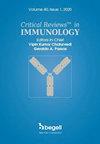电针通过激活 mTOR/SREBP1 通路缓解缺血性中风
IF 0.9
4区 医学
Q4 IMMUNOLOGY
引用次数: 0
摘要
目的:缺血性中风(IS)是导致全球死亡和残疾的主要原因之一。电针(EA)对缺血性中风有神经保护作用。然而,电针抗缺血性中风的具体机制仍有待进一步阐明。因此,我们旨在研究 EA 的抗 IS 作用及其机制:方法:通过构建大鼠 IS(大脑中动脉闭塞,MCAO)模型并进行 EA 治疗,评估神经功能缺损评分、脑水含量和脑梗死情况。采用 ELISA 法测量氧化应激(OS)相关分子(MDA、SOD、GSH 和 CAT)的水平。用 Western 印迹法评估了大鼠大脑半影中的铁氧化相关蛋白(GPX4、SLC7A11、TfR1、L-铁蛋白和 hepcidin)、神经损伤相关蛋白(GFAP、Iba-1 和 Nestin)、α7nAChR 和 mTOR 通路相关蛋白(mTOR、p-mTOR 和 SREBP1):结果:EA治疗后,MCAO大鼠脑半影的神经功能缺损评分、脑含水量、脑梗死程度以及GFAP、Iba-1和Nestin的表达均有所降低。此外,EA 还能降低 MCAO 大鼠脑半影区的 MDA 水平,提高 SOD、GSH 和 CAT 水平。此外,EA 治疗后,MCAO 大鼠脑半影中 GPX4 和 SLC7A11 表达升高,TfR1、L-铁蛋白和血钙素降低。EA治疗后,MCAO大鼠脑半影中的α7nAChR、mTOR、p-mTOR和SREBP1表达上调:结论:EA治疗可抑制OS和铁突变,从而对IS产生神经保护作用,这可能是通过激活mTOR/SREBP1信号传导实现的。本文章由计算机程序翻译,如有差异,请以英文原文为准。
Electroacupuncture Alleviates Ischemic Stroke by Activating the mTOR/SREBP1 Pathway
Objective: Ischemic stroke (IS) is one of the leading causes of death and disability worldwide. Electroacupuncture (EA) has been shown to exert a neuroprotective effect in IS. However, the specific anti-IS mechanisms of EA remain to be further elucidated. Thus, we aimed to investigate the anti-IS role of EA and its mechanism.
Methods: By constructing a rat IS (middle cerebral artery occlusion, MCAO) model and performing EA treatment, the neurological deficit score, brain water content, and cerebral infarction were evaluated. ELISA was used to measure the levels of oxidative stress (OS)-related molecules (MDA, SOD, GSH, and CAT). Ferroptosis-related proteins (GPX4, SLC7A11, TfR1, L-ferritin, and hepcidin), neurological damage-related proteins (GFAP, Iba-1, and Nestin), α7nAChR, and mTOR pathway-related proteins (mTOR, p-mTOR, and SREBP1) in rat brain penumbra were assessed using western blotting.
Results: Following EA treatment, the neurological deficit score, brain water content, cerebral infarction, and GFAP, Iba-1, and Nestin expression were reduced in the brain penumbra of MCAO rats. Additionally, EA treatment decreased MDA level and increased SOD, GSH, and CAT levels in the brain penumbra of MCAO rats. Moreover, MCAO rats showed elevated GPX4 and SLC7A11 expression and reduced TfR1, L-ferritin, and hepcidin in the brain penumbra following EA treatment. After EA treatment, α7nAChR, mTOR, p-mTOR, and SREBP1 expression were upregulated in the brain penumbra of MCAO rats.
Conclusions: EA treatment inhibited OS and ferroptosis to exert a neuroprotective effect in IS, which might be realized via the activation of mTOR/SREBP1 signaling.
求助全文
通过发布文献求助,成功后即可免费获取论文全文。
去求助
来源期刊
CiteScore
2.60
自引率
0.00%
发文量
14
审稿时长
>12 weeks
期刊介绍:
Immunology covers a broad spectrum of investigations at the genes, molecular, cellular, organ and system levels to reveal defense mechanisms against pathogens as well as protection against tumors and autoimmune diseases. The great advances in immunology in recent years make this field one of the most dynamic and rapidly growing in medical sciences. Critical ReviewsTM in Immunology (CRI) seeks to present a balanced overview of contemporary adaptive and innate immune responses related to autoimmunity, tumor, microbe, transplantation, neuroimmunology, immune regulation and immunotherapy from basic to translational aspects in health and disease. The articles that appear in CRI are mostly obtained by invitations to active investigators. But the journal will also consider proposals from the scientific community. Interested investigators should send their inquiries to the editor before submitting a manuscript.

 求助内容:
求助内容: 应助结果提醒方式:
应助结果提醒方式:


